Abstract
The in vivo functions of interleukin-3 (IL-3) were investigated by generating IL-3–deficient mice. Although hematopoiesis was unimpaired in homozygous mutant animals, contact hypersensitivity reactions were compromised. IL-3 was required for efficient priming of hapten-specific contact hypersensitivity responses, but was dispensable for T-cell–dependent sensitization to tumor cells. These findings reveal a critical role for IL-3 in some forms of delayed-type hypersensitivity.
INTERLEUKIN-3 (IL-3) is a 28-kD glycoprotein initially identified by its ability to induce the expression of 20α-hydroxysteroid dehydrogenase in cultures of nude mouse spleen cells.1 Subsequent work showed that the cytokine can promote the in vitro differentiation and proliferation of hematopoietic progenitors, yielding multipotential blast cells, mast cells, basophils, neutrophils, macrophages, eosinophils, erythrocytes, megakaryocytes, and dendritic cells.2-4 Administration of IL-3 to mice, monkeys, and humans can stimulate hematopoiesis in vivo as well.5-8 IL-3 can also enhance antigen presentation for T-cell–dependent responses, augment macrophage cytotoxicity and adhesion, and promote the function of eosinophils, basophils, and mast cells.9-13
Despite these numerous activities, the functions of IL-3 in vivo remain unclear. Mice carrying an inactivating mutation in the α-chain of the heterodimeric IL-3 receptor are apparently normal, and hematopoiesis can occur in vitro in the absence of IL-3.14,15 While T lymphocytes and mast cells can produce IL-3 in culture, the sources and circumstances in which IL-3 is expressed in vivo are not fully defined.16 17 To elucidate further the in vivo roles of this molecule, we generated mice lacking IL-3 by homologous recombination in embryonic stem (ES) cells.
MATERIALS AND METHODS
Generation of IL-3–deficient mice.
A 9.1-kb Xba I fragment and 3.1-kb BamHI-EcoRI fragment spanning the murine IL-3 locus were isolated from a 129S ES cell genomic library and inserted into the targeting vector pPNT.18 The HindIII site in exon 1 was destroyed during the construction. This vector was electroporated into D3 ES cells19 and clones resistant to G418 and ganciclovir were analyzed by Southern analysis as previously described.18The 600-bp probe indicated in Fig 1 was used to identify the 6.5-kb wild type and 9.5-kb targeted fragments after HindIII digestion. Targeted clones were injected into C57BL/6 blastocysts as described to generate chimeric animals transmitting the mutant allele through the germ line.20Heterozygous mice were mated to generate mice homozygous for the targeted mutation. For genotyping of animals, tail DNA was digested with HindIII and probed as above. The IL-3 mutation was backcrossed four generations onto both the BALB/c and C57BL/6 strains.
Generation of IL-3–deficient mice. (A) Structure of IL-3 targeting vector and disrupted IL-3 gene. The 600-bp probe indicated identifies the 6.5-kb wild-type and 9.5-kb targeted fragments afterHindIII digestion as shown. X, Xba I; H,HindIII; B, BamHI; R, EcoRT. (B) Genotype of mutant animals. Tail DNA was digested with HindIII and probed as above. Molecular sizes are indicated on the left (in kilobases).
Generation of IL-3–deficient mice. (A) Structure of IL-3 targeting vector and disrupted IL-3 gene. The 600-bp probe indicated identifies the 6.5-kb wild-type and 9.5-kb targeted fragments afterHindIII digestion as shown. X, Xba I; H,HindIII; B, BamHI; R, EcoRT. (B) Genotype of mutant animals. Tail DNA was digested with HindIII and probed as above. Molecular sizes are indicated on the left (in kilobases).
Hematologic evaluation.
Peripheral blood was analyzed for hematocrit, total and differential white blood cell counts, and platelet counts, and bone marrow cells and splenocytes were assayed for CFU-G, CFU-M, CFU-GM, and CFU-GEMM as previously described.21 For bone marrow transplantation experiments, 5 × 106 nucleated blood cells harvested from donor femurs were injected into lethally irradiated recipients (1,100 rads in two doses). Peripheral blood counts were determined at days 9, 23, 64, and 100 posttransplantation.
Contact hypersensitivity.
Mice at least 6 weeks of age were sensitized on day 0 with 50 μL of 4% 4-ethoxymethylene-2-phenyl-2-oxazolin-5-one (oxazolone; Sigma, St Louis, MO) in acetone/olive oil (4/1) painted onto the shaved abdomen and were challenged on day 5 with 20 μL of 0.5% oxazolone or carrier only painted on the left and right ear, respectively. To assess responsiveness to 2,4-dinitrofluorobenzene (DNFB; Sigma), mice were sensitized on days 0 and 1 with 20 μL of 0.5% DNFB in acetone/olive oil (4/1) and then challenged on day 5 with 20 μL with 0.2% DNFB. To assess responsiveness to fluorescein isothiocyanate (FITC; Sigma), mice were sensitized on day 0 with 400 μL of 0.5% FITC in acetone/dibutyl pthalate (1/1) and challenged on day 6 with 20 μL of 0.5% FITC. The hapten-specific increase in ear thickness at 24 hours was determined with a micrometer. For analysis of fibrin deposition,125I-labeled guinea pig fibrinogen was injected intravenously 10 minutes before secondary oxazolone challenge in sensitized mice. Twenty-four hours later ears were removed and the urea insoluble extract (cross-linked fibrin) assayed for 125I as previously described.22
Tumor vaccinations.
Female mice (on the BALB/c background) were immunized subcutaneously on the abdomen with 5 × 105 irradiated (3,300 rads) RENCA carcinoma cells (cultured in DME plus 10% fetal calf serum and antibiotics) and challenged 7 days later with 1 × 107 live RENCA cells subcutaneously on the back. Mice were killed when challenge tumors reached 2 cm in diameter. RENCA cells do not secrete detectable IL-3 as measured by enzyme-linked immunosorbent assay (ELISA) with a sensitivity of 25 pg/mL. For evaluation of delayed-type hypersensitivity to tumor cells, female BALB/c mice were immunized subcutaneously on the abdomen with 5 × 105irradiated RENCA carcinoma cells and 7 days later were injected in the footpads with 5 × 106 irradiated RENCA cells. Tumor-induced footpad swelling at 24 hours was determined with a micrometer. For haptenized tumor cell experiments, irradiated RENCA cells were incubated for 15 minutes at 37°C in 70 mmol/L oxazolone (dissolved in Hanks' balanced salt solution [HBSS] and ethanol, pH 7). The cells were then extensively washed with HBSS and injected subcutaneously for sensitization.
Cytokine mRNA expression.
Total RNA was obtained with TRIZOL (GIBCO-BRL, Grand Island, NY) according to the manufacturer's instructions. cDNA was synthesized using oligo-dT primers and MMLV reverse transcriptase (GIBCO-BRL). Polymerase chain reaction (PCR) was performed using published IL-3 primers.23 Amplified bands were confirmed as IL-3 by Southern blotting using IL-3 cDNA as a probe.
RESULTS AND DISCUSSION
Development of mice lacking IL-3.
To generate a null allele of the IL-3 gene, a neomycin-resistance cassette was introduced by homologous recombination into the third exon of the IL-3 locus (Fig 1A). Targeted clones were injected into C57BL/6 blastocysts to yield chimeric animals, which were then mated with C57BL/6 mice to obtain germline transmission of the mutant allele. Heterozygous mutant animals were interbred to generate homozygous IL-3–deficient animals (Fig 1B). Mutant mice were obtained at the expected frequencies, remained clinically healthy throughout 18 months of observation, and were fertile. Supernatants of concanavalin A–stimulated splenocytes from mutant animals showed no immunoreactive or bioactive IL-3, as determined by both proliferative studies with the 32D myeloid cell line24 and ELISA (not shown).
Complete pathologic examination of IL-3–deficient animals showed no abnormalities. Analysis of steady-state hematopoiesis demonstrated normal numbers of peripheral blood cells, bone marrow and splenic hematopoietic progenitors (as measured by colony-forming unit assays), and tissue hematopoietic populations. Bone marrow obtained from IL-3–deficient mice reconstituted lethally irradiated IL-3–deficient recipients with comparable kinetics as wild-type marrow transplanted into wild-type recipients. These results, which are consistent with recently reported findings,25 show that IL-3 is dispensable for normal hematopoiesis in vivo.
Impaired contact hypersensitivity reactions in IL-3–deficient mice.
To evaluate the potential role of IL-3 in T-cell–dependent immunity, wild-type and mutant animals were tested for the development of contact hypersensitivity to epicutaneously applied oxazolone. Contact hypersensitivity is a form of delayed-type hypersensitivity in which hapten-protein conjugates formed in the skin are presented by epidermal Langerhans cells, following their migration to regional lymph nodes, to hapten-specific CD4+ and CD8+ T lymphocytes.26-28 Sensitized T cells initiate a local inflammatory response in the skin upon secondary hapten challenge. Although IL-3–deficient mice were indistinguishable from wild-type littermates in the magnitude of their immunologically nonspecific “irritant” response to initial hapten challenge (data not shown), they exhibited significantly compromised reactivity upon secondary hapten challenge, as measured by ear swelling (Fig2A). Impairment was evident in nine experiments with IL-3–deficient mice in the C57BL/6 background and seven experiments in the BALB/c background, and was also observed in four other experiments in which 2,4-dinitrofluorobenzene or fluorescein isothiocyanate were used as haptens.
Delayed-type hypersensitivity reactions. (A) Contact hypersensitivity reactions to oxazolone in IL-3–deficient (□) and wild-type littermates (▪). Values (n = 5) are mean ± SEM: C57BL/6, P = .025; BALB/c, P = .014. (B) Fibrin deposition during contact hypersensitivity to oxazolone (C57BL/6 background). P < .001 for oxazolone challenge. Plasma values for 125I-labeled fibrinogen 24 hours after injection were 1,948 ± 61.7 for +/+ mice and 1,879 ± 53.3 cpm for −/− animals. (C) Tumor protection in immunized female IL-3–deficient (▵) and wild-type littermates (○) (BALB/c background). Wild-type controls, no vaccine (□). All surviving animals at day 55 were tumor free. Pooled results from two independent experiments (10 mice per group). (D) Delayed-type hypersensitivity to irradiated tumor cells inoculated in the footpads of immunized female IL-3–deficient (□) and wild-type littermate mice (▪) (BALB/c background).
Delayed-type hypersensitivity reactions. (A) Contact hypersensitivity reactions to oxazolone in IL-3–deficient (□) and wild-type littermates (▪). Values (n = 5) are mean ± SEM: C57BL/6, P = .025; BALB/c, P = .014. (B) Fibrin deposition during contact hypersensitivity to oxazolone (C57BL/6 background). P < .001 for oxazolone challenge. Plasma values for 125I-labeled fibrinogen 24 hours after injection were 1,948 ± 61.7 for +/+ mice and 1,879 ± 53.3 cpm for −/− animals. (C) Tumor protection in immunized female IL-3–deficient (▵) and wild-type littermates (○) (BALB/c background). Wild-type controls, no vaccine (□). All surviving animals at day 55 were tumor free. Pooled results from two independent experiments (10 mice per group). (D) Delayed-type hypersensitivity to irradiated tumor cells inoculated in the footpads of immunized female IL-3–deficient (□) and wild-type littermate mice (▪) (BALB/c background).
To examine the defective contact hypersensitivity reaction in more detail, 125I-fibrinogen was injected systemically into IL-3–deficient and wild-type control mice at the time of secondary oxazolone challenge.22 The conversion of fibrinogen to cross-linked fibrin at the challenge site results in the induration characteristic of cutaneous delayed-type hypersensitivity responses. Significantly less cross-linked fibrin was present in the ears of IL-3–deficient mice as compared with wild-type littermates (Fig 2B), confirming a marked reduction in the magnitude of the hapten-specific immune response.
Although no histolopathologic differences between IL-3–deficient and wild-type mice were noted in untreated skin or in skin at the sensitization site, marked differences were apparent in the challenge site (Fig 3B and C). In wild-type animals, the inflammatory response was characterized by an intense cellular infiltrate consisting predominantly of neutrophils, lymphocytes, and eosinophils, as well as substantial dermal edema, hyperkeratosis, and focal intraepidermal abscesses. IL-3–deficient animals, in contrast, developed a dramatically less intense cellular infiltrate, although the cellular composition was similar to that of wild-type animals. IL-3–deficient mice also demonstrated less edema, fewer and smaller intraepidermal abscesses, and little keratinocyte activation. The number of Langerhans cells in the skin of unmanipulated IL-3–deficient mice, as determined by immunofluorescence staining of major histocompatibility complex class II positive cells in epidermal ear sheets, however, was comparable to that of wild-type littermate controls (1,663 ± 362 v 1,433 ± 271/mm2 of epidermal surface for IL-3–deficient and wild-type animals).
IL-3 is required for hapten specific priming. (A) IL-3–deficient (□) and wild-type littermate controls (▪) (BALB/c) were tested for contact hypersensitivity to oxazolone. One hundred nanograms of murine IL-3 (in 1% mouse serum) (□) or vehicle only was administered intraperitoneally and subcutaneously (abdomen) 4 hours before, at the time of sensitization, and 6 hours afterwards. +/+ versus −/−, P = .03. −/− plus murine IL-3 versus −/−, P = .008. Murine IL-3 administered to unsensitized mice had no effect on secondary challenge. (B through D) Histopathology (tissues were formalin-fixed, paraffin-embedded, and stained with hematoxylin and eosin) of secondary oxazolone challenge sites in ears from mice (BALB/c background) killed 24 hours after challenge. (B) Ear reaction of a sensitized wild-type mouse. (C) Ear reaction of a sensitized IL-3–deficient mouse. (D) Ear reaction of a sensitized IL-3–deficient mouse administered IL-3 protein at the time of priming.
IL-3 is required for hapten specific priming. (A) IL-3–deficient (□) and wild-type littermate controls (▪) (BALB/c) were tested for contact hypersensitivity to oxazolone. One hundred nanograms of murine IL-3 (in 1% mouse serum) (□) or vehicle only was administered intraperitoneally and subcutaneously (abdomen) 4 hours before, at the time of sensitization, and 6 hours afterwards. +/+ versus −/−, P = .03. −/− plus murine IL-3 versus −/−, P = .008. Murine IL-3 administered to unsensitized mice had no effect on secondary challenge. (B through D) Histopathology (tissues were formalin-fixed, paraffin-embedded, and stained with hematoxylin and eosin) of secondary oxazolone challenge sites in ears from mice (BALB/c background) killed 24 hours after challenge. (B) Ear reaction of a sensitized wild-type mouse. (C) Ear reaction of a sensitized IL-3–deficient mouse. (D) Ear reaction of a sensitized IL-3–deficient mouse administered IL-3 protein at the time of priming.
Tumor vaccination responses in IL-3–deficient mice.
To address the potential involvement of IL-3 in another type of cutaneous delayed-type hypersensitivity reaction, we evaluated the ability of IL-3–deficient mice to generate antitumor immunity after vaccination with irradiated tumor cells. Tumor immunization in this system, like contact hypersensitivity,28 is dependent on CD4+ and CD8+ T cells (J. Donahue and G. Dranoff, manuscript in preparation). Nonetheless, IL-3–deficient mice showed no impairment in tumor vaccination, as measured by the ability to reject a secondary challenge of live tumor cells, under conditions where immunized wild-type mice demonstrated only partial protection against tumor challenge (Fig 2C). Moreover, tumorigenicity in naive IL-3–deficient mice was indistinguishable from wild-type littermates. Pathologic examination of tumor rejection sites in immunized animals showed no significant differences between IL-3–deficient and wild-type mice. The generation of antitumor immunity was also assessed by injecting irradiated tumor cells into the footpads of previously vaccinated animals. No differences were observed between IL-3–deficient and wild-type mice, as measured by tumor-induced footpad swelling (Fig 2D).
IL-3 expression during delayed-type hypersensitivity.
To investigate the potential basis for the differing requirements for IL-3 in the two forms of delayed-type hypersensitivity, the expression of IL-3 in the skin during the priming phases of the two responses was examined by reverse transcriptase (RT)-PCR (Table1). Although IL-3 transcripts were not detected in unmanipulated or shaved skin, or in skin treated only with diluent, the application of hapten rapidly induced IL-3 transcripts in wild-type, but not IL-3–deficient, animals. Expression was detected as early as 1 hour after hapten painting and persisted for up to 4 days. IL-3 transcripts were also found in the draining lymph node of the sensitization site 24 hours after hapten application. In contrast to these findings, IL-3 transcripts were not detected in the skin of wild-type mice after vaccination with irradiated tumor cells.
IL-3 Expression During Delayed-Type Hypersensitivity Responses
| Antigen . | Time After Priming (h) . | |||||
|---|---|---|---|---|---|---|
| 0 . | 1 . | 12 . | 24 . | 48 . | 96 . | |
| None | 0-150/8-151 | — | — | 0/8-152 | — | — |
| Vehicle only-153 | — | — | 0/5 | 0/5 | — | — |
| Oxazolone | — | 4/4 | 4/4 | 8/10 | 4/10 | 3/8 |
| Tumor cells-155 | — | — | — | 0/4 | 0/4 | — |
| Antigen . | Time After Priming (h) . | |||||
|---|---|---|---|---|---|---|
| 0 . | 1 . | 12 . | 24 . | 48 . | 96 . | |
| None | 0-150/8-151 | — | — | 0/8-152 | — | — |
| Vehicle only-153 | — | — | 0/5 | 0/5 | — | — |
| Oxazolone | — | 4/4 | 4/4 | 8/10 | 4/10 | 3/8 |
| Tumor cells-155 | — | — | — | 0/4 | 0/4 | — |
Wild-type mice (BALB/c) were sensitized with the indicated antigen, and the presence of IL-3 transcripts at varying times in the skin at the priming site was evaluated by RT-PCR. No message was detectable in IL-3–deficient mice.
Number of mice positive for IL-3 transcripts.
Number of mice tested.
Shaved only.
Acetone/olive oil.
Irradiated RENCA carcinoma cells (3,300 rads).
To evaluate the potential role of IL-3 during the priming phase of contact hypersensitivity, IL-3 protein was administered subcutaneously and intraperitoneally at the time of sensitization to IL-3–deficient animals. This resulted in partial correction of the impaired response, as measured by ear swelling (Fig 3A). Moreover, pathologic analysis showed a significant increase in the intensity of the inflammatory response in comparison to untreated mutant animals, but the reaction did not reach wild-type levels (Fig 3D). The inability to correct completely the defective response in IL-3–deficient mice could be due to either pharmacologic limitations in the delivery of IL-3 protein or a second role for IL-3 during the elicitation phase. Indeed, IL-3 transcripts were also detected in the skin upon secondary hapten challenge, and previous work has shown that administering neutralizing antibodies to both IL-3 and granulocyte-macrophage colony-stimulating factor during the elicitation phase can reduce the intensity of the reaction.29 However, attempts to correct the impaired response in IL-3–deficient mice by providing IL-3 at the time of elicitation were unsuccessful.
The requirement for IL-3 during delayed-type hypersensitivity to haptens, but not tumor cells, demonstrates that distinct pathways underlie the generation of T-cell immunity in the skin. In this context, sensitization with haptenated tumor cells was also compromised in IL-3–deficient mice (data not shown), suggesting that intact priming to tumor cells could not overcome the IL-3–associated impairment in hapten-specific responses. Further studies will be necessary to delineate whether different antigen presenting cells or functions are involved in the responses to haptens and tumor cells, and whether other techniques of hapten administration can bypass the defect shown here or whether other techniques of tumor vaccination are dependent on IL-3. The sources of IL-3 production in normal skin remain to be clarified as well, although Langerhans cells, mast cells, and keratinocytes are possibilities. Finally, our results suggest that IL-3 antagonists might be effective therapies for contact dermatitis in humans.
ACKNOWLEDGMENT
All mouse experiments were approved by the AAALAC-accredited DFCI IACUC. We thank C. Crawford, A. Crawford, B. Ream, K. Edelman, R. Bronson, and V. Tybulewicz for their excellent help. We thank the staff of the Redstone Animal Facility for their excellent maintenance of the mouse colony.
Supported by the Claudia Adams Barr Foundation, a Young Markey Scientist Award, the Cancer Research Institute/Partridge Foundation (G.D.), the Swiss National Science Foundation (N.M.), CA72074 and AI23990 (S.J.G.), and AR40667 (R.G.).
Address reprint requests to Glenn Dranoff, MD, Dana-Farber Cancer Institute, Dana 710E, 44 Binney St, Boston, MA 02115.
The publication costs of this article were defrayed in part by page charge payment. This article must therefore be hereby marked “advertisement” in accordance with 18 U.S.C. section 1734 solely to indicate this fact.


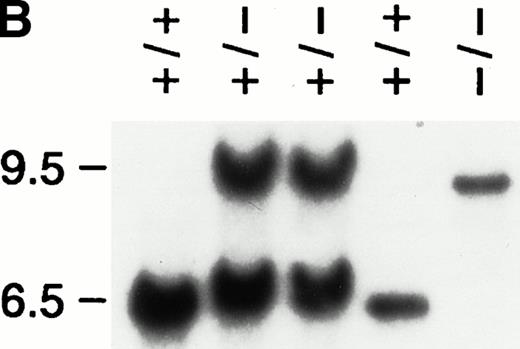
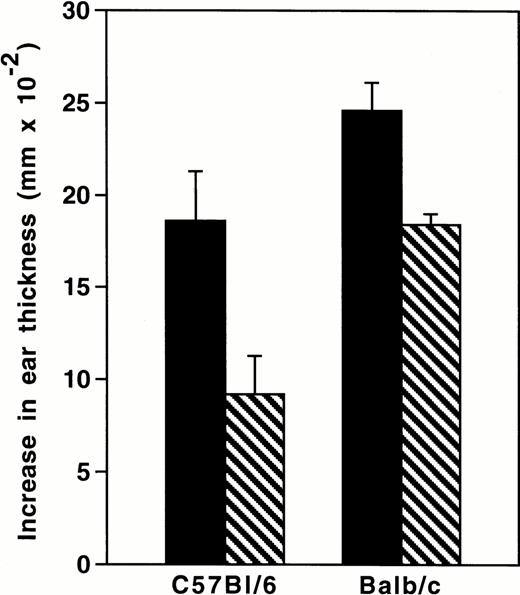
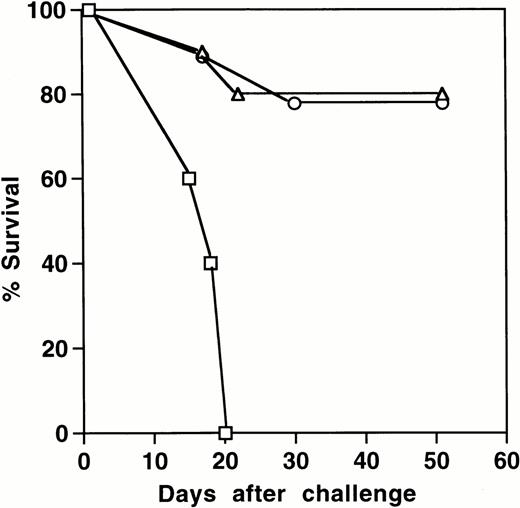
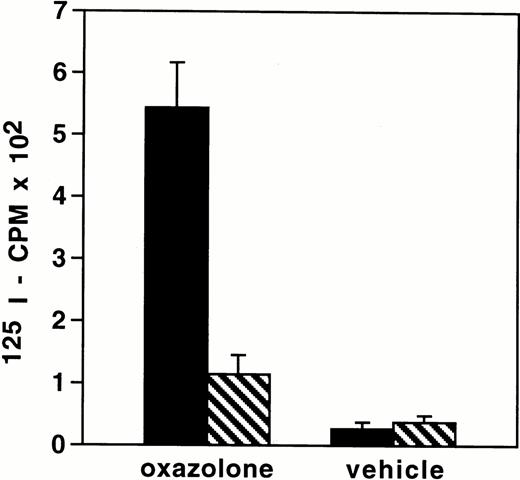

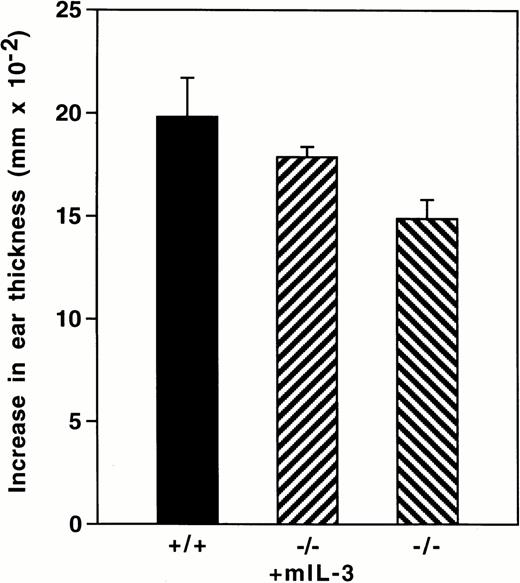
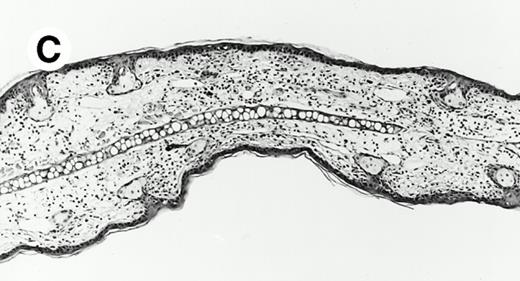
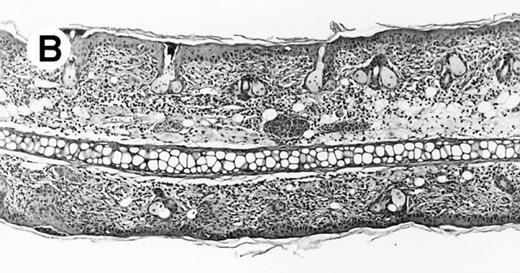

This feature is available to Subscribers Only
Sign In or Create an Account Close Modal